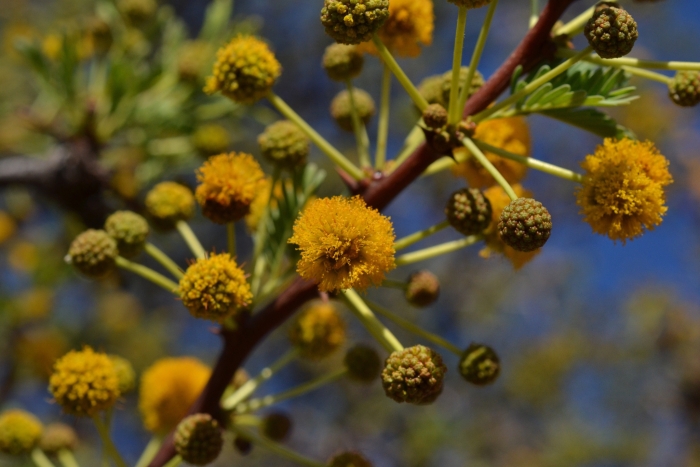Camel Thorn
(Vachellia erioloba)
Camel Thorn (Vachellia erioloba)
/
/

Sam McCarren
CC BY 4.0
Image By:
Sam McCarren
Recorded By:
Copyright:
CC BY 4.0
Copyright Notice:
Photo by: Sam McCarren | License Type: CC BY 4.0 | License URL: http://creativecommons.org/licenses/by/4.0/ | Rights Holder: Sam McCarren | Publisher: iNaturalist | Date Created: 2019-09-12T12:55:08Z |






























Estimated Native Range
Summary
Vachellia erioloba, commonly known as the Camel Thorn or Giraffe Thorn, and referred to as Kameeldoring in Afrikaans, is a tree native to arid regions of Southern Africa, including the Kalahari Desert and other semi-desert areas. This tree is a slow-growing, deciduous species that can reach up to 20 meters in height, with a deep taproot system that makes it highly resilient to drought conditions and fairly frost-resistant. The Camel Thorn’s distinctive light-grey thorns, which reflect sunlight, and its bipinnate leaves that close during the heat of the day, are adaptations to its hot, arid native habitat. The wood of Vachellia erioloba is dark reddish-brown, extremely dense, and strong, making it valuable for furniture and fence posts.
The Camel Thorn is known for its yellow flowers that bloom in the spring and summer, adding seasonal interest to landscapes. It is valued in cultivation for its drought tolerance and ability to thrive in full sun with minimal water requirements. While it is not commonly used in small gardens due to its large size, it is suitable for larger landscapes, parks, and as a feature tree in xeriscaping projects. Due to its hardy nature, it requires well-drained soil and can tolerate poor soil conditions. Gardeners should be aware that its strong wood and thorns can make maintenance challenging, and its deep root system may interfere with nearby structures if not given enough space to grow.CC BY-SA 4.0
The Camel Thorn is known for its yellow flowers that bloom in the spring and summer, adding seasonal interest to landscapes. It is valued in cultivation for its drought tolerance and ability to thrive in full sun with minimal water requirements. While it is not commonly used in small gardens due to its large size, it is suitable for larger landscapes, parks, and as a feature tree in xeriscaping projects. Due to its hardy nature, it requires well-drained soil and can tolerate poor soil conditions. Gardeners should be aware that its strong wood and thorns can make maintenance challenging, and its deep root system may interfere with nearby structures if not given enough space to grow.CC BY-SA 4.0
Plant Description
- Plant Type: Tree
- Height: 20-35 feet
- Width: 20-35 feet
- Growth Rate: Moderate
- Flower Color: Yellow
- Flowering Season: Spring, Summer
- Leaf Retention: Evergreen
Growth Requirements
- Sun: Full Sun
- Water: Low
- Drainage: Medium
Common Uses
Bee Garden, Bird Garden, Butterfly Garden, Drought Tolerant, Fragrant, Low Maintenance, Showy Flowers
Natural Habitat
Native to arid regions of Southern Africa, including the Kalahari Desert and other semi-desert areas
Other Names
Common Names: Camel Thorn, Giraffe Thorn, Kameeldoring
Scientific Names: , Vachellia erioloba, Acacia erioloba, Acacia giraffae, Acacia giraffae var. espinosa, Mimosa cameleopardalis, Mimosa giraffae, Vachellia giraffae,
GBIF Accepted Name: Vachellia erioloba (E.Mey.) P.J.H.Hurter